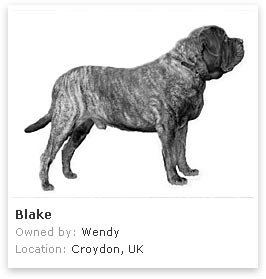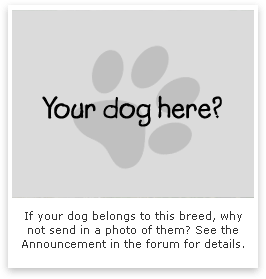OriginKnown also as the English Mastiff or Old English Mastiff this is one of the most ancient of breeds. The exact origin is obscure but Mastiff-type dogs are depicted and described on antiquities from Europe and Asia as far back as 2,200 B.C. When the Romans invaded Britain they found these huge and courageous dogs fighting alongside their masters in battle. Many were sent back to Rome to fight gladiators, other dogs, and wild animals for the entertainment of the public. A favoured and valued dog of the English nobility, in medieval times they were used as hunting dogs and war dogs, as well as for guarding and the ‘sport’ of bear baiting. Prominent throughout English history the breed suffered a severe decline in the early and mid 20th century due to the privations of both world wars and the consequent difficulty of feeding, maintaining, and breeding such large dogs. It is estimated that in 1945 only 20 pure Mastiffs existed in Britain, and by 1947 the number had dropped to seven. Fortunately many had been exported to the U.S.A. and Canada and the breed was revived by using imports from those countries.
Character:“His courage does not exceed his temper and generosity, and in attachment he equals the kindest of his race. His docility is perfect ... “ (Cynographia Britannica, 1800).
Once a ferocious warrior ready and more than willing to take on all-comers, man or beast, the well-bred Mastiff of today is a sweet-natured, patient, gentle dog lacking any vices. Calm, patient, and usually tolerant of children he is an ideal family companion for those that have the space and the financial resources for feeding and routine veterinary care, and who can accept a certain amount of drool and snoring. This is a very sociable and affectionate breed needing to be a true part of the family so they are quite unsuited to life in a kennel or long periods left alone in the backyard. Deprived of company a Mastiff will pine, grow anxious, and become destructive. He wants to be with you and to know that he is an important part of your life. If his affection and loyalty are returned you will have one of the most faithful of friends. As a guarding breed the Mastiff will protect home and family to the best of his ability - not by throwing his weight around and frivolous barking but in a controlled and watchful manner, alert for anything that may pose a threat. The Mastiff’s instinct is to hold at bay rather than attack, but his great size, imposing presence, and impressive voice would be enough of a warning for all but the most foolhardy.
Exercise:It is vitally important that great care should be taken with Mastiff puppies. Puppies should be allowed to set their own limits and to rest when they want to. No formal exercise should be undertaken until around nine months of age and then it must be built up very gradually. Short, slow walks and gentle play, no stairs, no slippery floors, no jumping or rough-housing with other dogs or people will help to avoid future crippling damage to joints and bones. A physically slow maturing breed most Mastiffs do not complete growth until at least two years of age. The adult Mastiff may be inclined to be a trifle lazy but regular walks in the cooler parts of the day are necessary to maintain musculature and fitness.
Training:Basic obedience training should be part of every Mastiff’s early life. One of the heaviest breeds in the world, it is essential that this huge and very powerful dog is trained to walk calmly on-lead and not to jump up at people. Mastiffs are very willing and try hard to please their owners, but they will ‘switch off’ if bored and will refuse to budge if confused or scared. They are extremely sensitive and can be crushed and intimidated by harsh physical or verbal corrections from people in whom they had put their trust. Positive training methods which reward with praise, hugs, and treats will bring out the best in a Mastiff. Socialization from a young age, with both dogs and people, is important as inadequate socialization may give rise to fearfulness or aggression.
|
KC Group:
Working
KC, AKC, FCI recognized?
Yes
Size:
Extra Large
Height:
Dogs: minimum 75 cm (30 ins)
Bitches: minimum 68 cm (27.5 ins)
Weight:
Dogs: about 72 kg (160 lbs)
Bitches: about 68 kg (150 lbs). Both dogs and bitches may weigh considerably more.
Colour:
Apricot-fawn, silver-fawn, fawn, dark fawn-brindle. Muzzle, nose and ears black.
Lifespan:
6 - 10 years
Coat:
Short, smooth
Grooming:
Easy
Health issues:
Eye problems, Anterior cruciate ligament (ACL) rupture, hip dysplasia, elbow dysplasia, hypertrophic osteodystrophy (HOD), panosteitis, cardiomyopathy, cancer, epilepsy, susceptible to bloat

|











